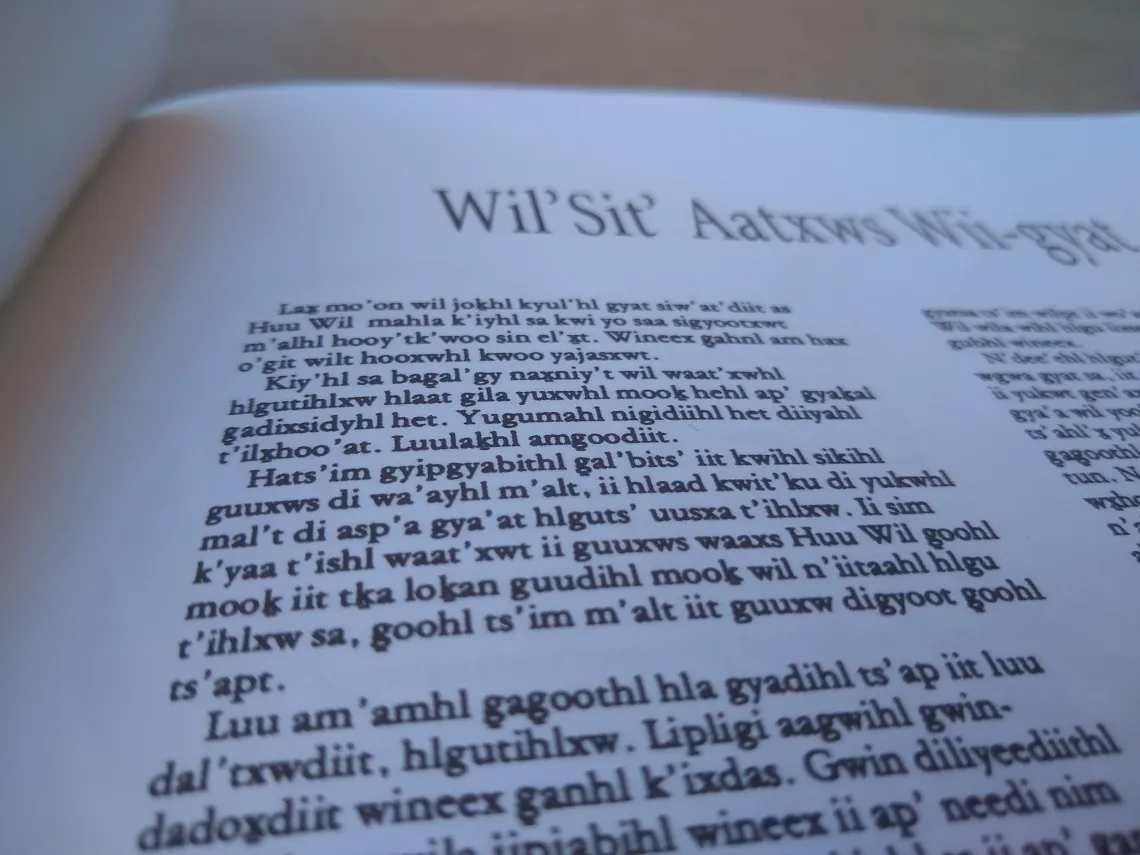Visiting Scholar Receives $60,000 NEH Fellowship Award to Document Endangered Language
Clarissa Forbes’ work on Gitksan embodies University of Arizona’s dedication to preserving Indigenous languages.

Gitksan-language book: "We-gyet Wanders on: Legends of the Northwest" by Gitanmaaxs band, Bookbuilders of 'Ksan
By Kristina Makansi, Research, Innovation & Impact
Clarissa Forbes, visiting scholar and postdoctoral researcher in the Department of Linguistics, was recently awarded a $60,000 fellowship from the National Endowment for the Humanities, or NEH, for her work documenting and developing a speech corpus for Gitksan, the traditional language of the Gitxsan people of Alaska and the northern interior of British Columbia.
The need for Gitksan documentation is urgent both due to a shift toward English promoted by the Canadian residential schools of the past and because the number of native speakers is rapidly diminishing – currently, there are approximately only 300-500 native speakers left, and the youngest of these are in their late fifties.
“Most documentary work on the language has been done in the last 40 years and much of it remains unpublished,” said Forbes, who received her B.A. at University of British Columbia in Vancouver and her M.A. and Ph.D. from the University of Toronto. “This funding will allow me to work on translating and transcribing more recordings and turning the collection of texts and recordings already translated and transcribed into an online repository accessible to the Gitxsan people and scholars."
The project's primary goal is the development of an online text repository that offers:
- a community-accessible body of narratives and conversations,
- a base of sample sentences for an existing community-accessible online dictionary in active development at the University of British Columbia, and
- a corpus for linguists working on Gitksan to view long-form narrative or conversational data.
Forbes’ work is a perfect fit for the University of Arizona’s linguistics department, which includes work on language endangerment, revitalization, documentation, rights, and reclamation within the United States and around the world.
The stories and texts Forbes works with include personal anecdotes, recipes, explanations of cultural traditions and objects, including, for instance, the role of blankets and the protocols for dealing with menstruation. Many of the stories are “trickster stories” intended to convey a moral that the listener must discern from the context of the tale.
Within Gitxsan culture, however, many stories are the property of specific houses and chiefs and, like trespassing on private land, outsiders are not allowed to reproduce them without specific permission. Forbes and other scholars, therefore, focus on those stories that are available to the community at large.
Gitksan, a part of the Tsimshianic family of languages, is spoken throughout the Skeena River watershed in northwest British Columbia – Gitxsan means the people of the Skeena River – and the traditional Gitxsan territory encompasses approximately 33,000 square kilometers. The stories Forbes works with come from the inland headwaters region, but the entire region is a continuum of people speaking similar languages and dialects.
“Some people can easily understand each other, and some can’t understand each other at all,” Forbes says. “What I’m most interested in documenting now are those dialects and comparing differences between villages. Native speakers can hear them and identify which village a speaker comes from, but the phonetic differences have not been documented.”
Forbes’s interest in documenting endangered languages was sparked when the instructor of one of her first linguistics classes arrived one day with an announcement. “She looked at the class and said, ‘I would like for us to have a moment of silence because one of the two remaining native speakers of the language I work on just passed away.’ It was very moving and brought it home for me that this work addresses a real and pressing issue.”
“To me, playing a role in documenting and preserving one language is a part of the larger work of helping people to understand that no matter where you are and where you come from, there were people and languages there before you, and that those people and those languages may still be right there with you now. And that’s why,” Forbes says, “the urgency for documentation and preservation is very real everywhere.”
Gitksan Audio Clip
Here is a clip of a story about the 17th century eruption at the Tseax Cone/Aiyansh Volcano. The story is told by Vincent Gogag:
Wilaayihl gyet win hlaa dim luu'nu'wdiit.
Sit'aa'mam sik'ihl huutdiit, ii needii helt gyet ji ant da'ak̲hlxw dim huutdiit.
Helthl gyethl dexwit win mihl 'wii sg̲a'nist tust.
Neehuxwdii hetxwhl sg̲a'nist g̲o'ohl win 'niihetxwit.
Way 'nig̲anhediit, "Needii sgidim anma'usxunhl ehl hun oo ligi k'i'yhl yejasxw."
People knew they were going to perish.
They tried to flee, but not many were able to flee.
Many people died when that big mountain burned.
No longer does the mountain stand where it used to.
So that's why they say, "Thou shall not play with fish or animals."

